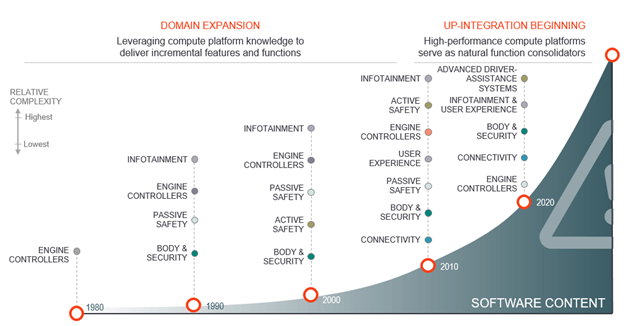Over the past 15 years, the automotive industry has shifted from emphasizing mechanical features like torque and horsepower to a software-centric approach emphasizing driver convenience, assistance, infotainment, and connectivity. This evolution is driven by changing customer expectations—today’s users seek continuous feature updates, personalized services, and on-demand functionalities even after purchasing a vehicle. These demands are pushing the industry toward Software Defined Vehicles (SDVs), which offer flexibility, upgradability, data-driven insights, and seamless connectivity. I witnessed how customer expectations began to mirror their digital lifestyles, treating vehicles as extensions of their smart devices. This transformation sparked my interest in how software could redefine user experiences and drive innovation in mobility.

Ref: https://www.aptiv.com/en/insights/article/what-is-a-software-defined-vehicle
Key technological trends and challenges shaping SDVs
There are already vehicles out there which are driven by software with hundreds of millions of lines of code in them. Today these vehicles that are deployed have software functions specific to certain vehicle functions leaving significant scope of flexibility. In previous decades, business and revenue trends used to drive up to product levels. Nowadays they drive decisions to a small chip/component level to complex software designs. So, these next generation vehicles are looking for technological trends in software that are driven by four factors: flexibility, upgradable, data driven and connected.
There are four trends that are increasingly demanding digital content in the vehicle.
- Flexibility: Flexibility to adapt to ever changing requirements and environments. One classic example is that a high-definition localization module would use a connectivity module to communicate environment changes like road closures to a server which in turn comes back as a software update to the unit in the vehicle.
- Upgradability: Easily and reliably upgradable to address the needs in the form of New behaviors, new functions and new applications. One use case would be to start the production of vehicles with just HW capability while the SW getting matured for production use. Push the software at a later point to provide the function to the customer after purchase of the vehicle.
- Data-Driven Design: Data that is collected by vehicle is pivotal to business as well as enhancing the technology. Vehicle technology would have many sensors, actuators and other input/output devices. ADAS and automating driving technologies have many sensors connected. Some of the data collected would be crucial to transfer it to the server which would allow the OEMs to improve the technology.
- Connectivity: Enables real-time communication and over-the-air updates.
Challenges include managing increasing software complexity, ensuring long-term software support, addressing cybersecurity and functional safety (FuSa), and maintaining quality and consistency across digital experiences.
How are customer expectations and digital content evolving in SDVs?
Customers now view their vehicles as extensions of their digital lifestyles, expecting seamless integration with smartphones and smart devices. Digital content in vehicles has evolved from basic engine controllers to include infotainment, safety systems, and connectivity. The future will likely involve services where customers or third parties (e.g., insurance companies) purchase vehicle data for various purposes, such as determining insurance premiums or investigating incidents.
The Unique Role of Digital Technology in SDVs and What the Future Holds
Digital technology stands out due to its ability to deliver an end-to-end, service-oriented user experience that blurs the line between home, road, and remote environments. Every bit and piece of digital technology has ways to enhance the user experiences and drive revenues for business in the ecosystem. Silicon development and selection are going to play an extremely vital role along with many other things. The future of SDVs is a long-term journey involving continuous innovation, collaboration across industries, and integration of AI and intelligent data systems. Key players like Qualcomm and Amazon (AWS) are already contributing to this ecosystem. The focus will be on enhancing user experiences, ensuring data security, and building resilient, scalable vehicle architectures.
Final Thoughts
We’re at the beginning of a long but exciting journey. SDVs are not just changing how vehicles are built—they’re changing how we think about mobility itself. As engineers, developers, and enthusiasts, we have the opportunity to shape this future.
What do you think? Are you ready for a world where your car updates itself like your phone? How do you feel about the growing role of data in driving decisions?
Let’s continue the conversation in the comments below.